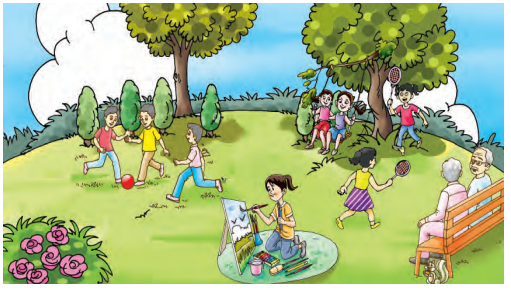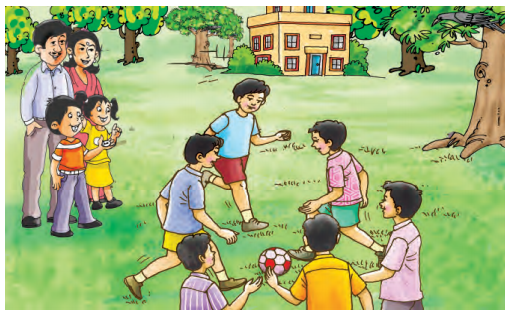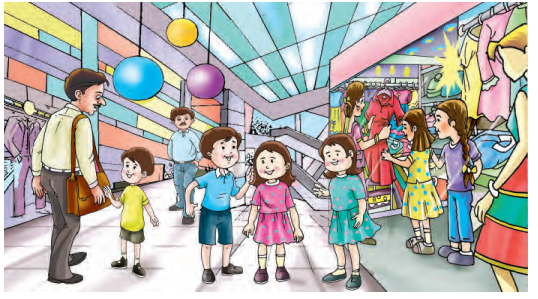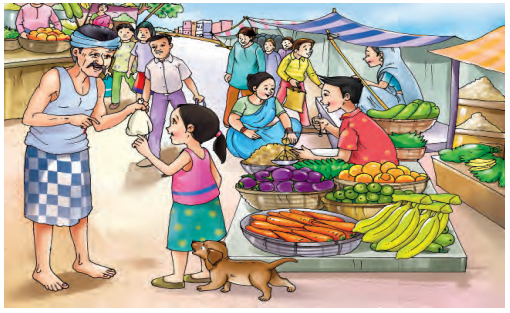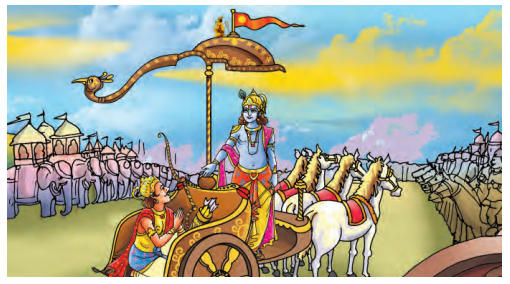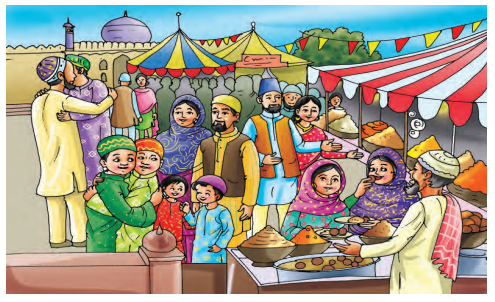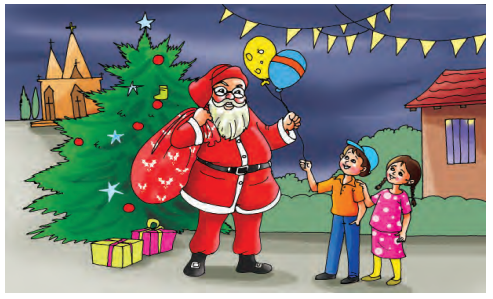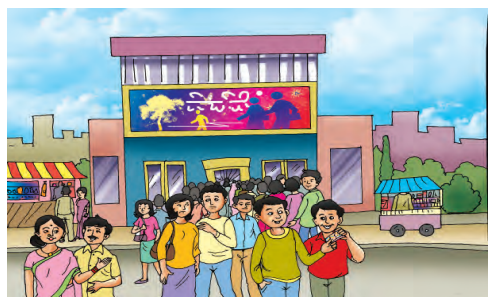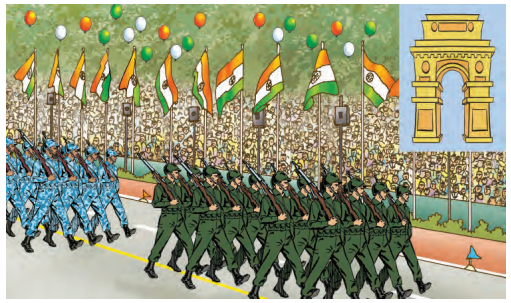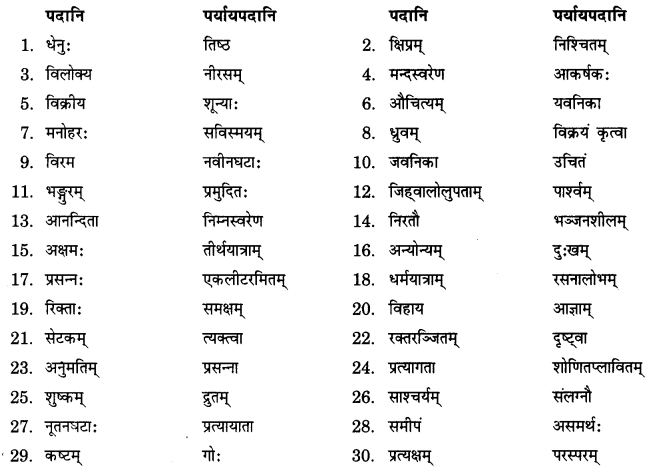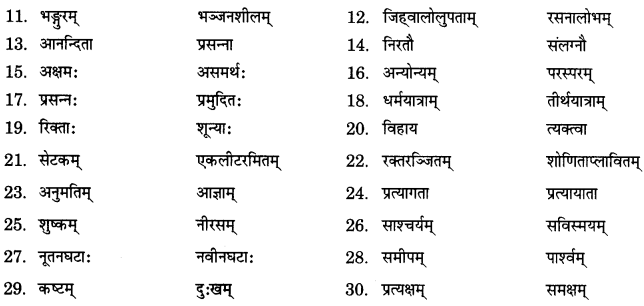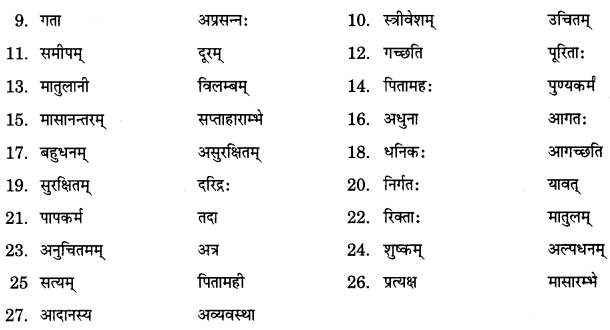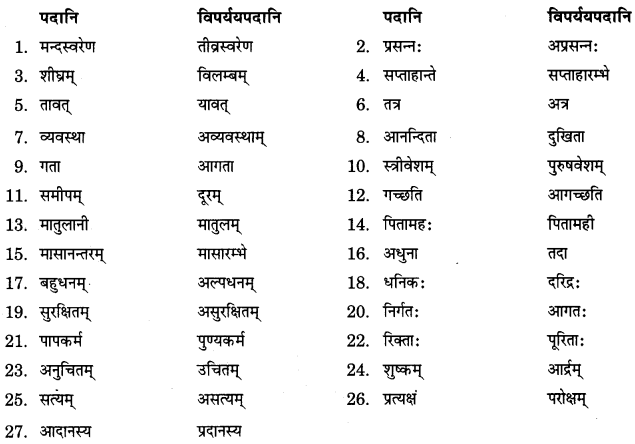We have given detailed NCERT Solutions for Class 9 Sanskrit Abhyasvan Bhav Sanskrit Class 9 Solutions Chapter 4 संवादानुच्छेदलेखनम् Questions and Answers come in handy for quickly completing your homework.
Abhyasvan Bhav Sanskrit Class 9 Solutions Chapter 4 संवादानुच्छेदलेखनम्
अभ्यासः
प्रश्न 1.
अधोलिखितसंवाद मञ्जूषाप्रदत्तवाक्यैः पूरयत –
लता – राधिके! प्रात:काले एव सज्नीभूय कुत्र गन्तुं सन्नद्धा?
राधिका – 1 – ………………………….
लता – विद्यालयम्! अस्यां वेशपूभायाम्? तव गणवेशः कुत्राऽस्ति?
राधिका – 2 – …………………………
लता – अहा। काव्यालिस्पर्धा! बहुशोभनम्। स्पर्धा तव विद्यालये एव अस्ति उत अपरस्मिन् विद्यालये?
राधिका – 3 – …………………………..
लता – त्वम् प्रतियोगितायां सम्यग्रूपेण प्रस्तुतिं कुर्याः इति मम शुभकामना।
राधिका – 4 – …………………………..
राधिका – 5 – …………………………….
मञ्जूषा
(क) शुभाऽस्ते सन्तु पन्थानः
(ख) अहं विद्यालयं गच्छामि।
(ग) धन्यवादः भगिनि।
(घ) विद्यालये नास्ति स्पर्धा, वयं शिक्षिकया सह अपर विद्यालयं गमिष्यामः।
(ङ) अद्य काव्यालि-प्रतियोगिता अस्ति, अहं प्रतियोगितायां भागं ग्रहीतुं सज्नीभूय गच्छामि।
उत्तर:
1 – (ख) अहं विद्यालयं गच्छामि।
2 – (ङ) अद्य काव्यालि-प्रतियोगिता अस्ति, अहं प्रतियोगितायां भागं ग्रहीतुं सज्नीभूय गच्छामि।
3 – (घ) विद्यालये नास्ति स्पर्धा, वयं शिक्षिकया सह अपर विद्यालयं गमिष्यामः।
4 – (ग) धन्यवादः भगिनि।
5 – (क) शुभाऽस्ते सन्तु पन्थानः
प्रश्न 2.
अधोलिखितसंवाद मञ्जूषाप्रदत्तवाक्यैः पूरयत –
राहुलः – अभिनव! नमोनमः! चिरात् दृष्टोऽसि?
अभिनव-1 – ………………………………..
राहुलः – अभिवादये तरुण! भवता सह मिलित्वा प्रसन्नोऽस्मि।
तरुणः-2 – …………………………………..
राहुलः – भवान् किं करोति?
तरुणः – अहं संस्कृतसाहित्ये स्नातकोत्तरपरीक्षा संपाद्य आगतोऽस्मि।
राहुल-3 – …………………………………..
तरुणः – किमर्थम्?
राहुलः-4 – …………………………………..
तरुणः – संस्कृतपठनेन सह वैज्ञानिकप्रविधीनाम् उपयोगे न कोऽपि दोषः? अहं तु सर्वाणि वैज्ञानिकोपकरणानि उपयोजयामि।
राहुलः – शोभनम्। 5 – …………………………………..
मञ्जूषा
(क) भवान् अधुनिक: वस्तैः सज्जः, बहुमूल्यं च चलदूरभाषयन्त्र धारयन् आधुनिक इव प्रतीयते।
(ख) मम मनसः भ्रान्तिरियम् अपगता यत् संस्कृताध्येतारः रूढिवादिनः भवन्ति।
(ग) अहमपि प्रसन्नोऽस्मि।
(घ) परं भवन्तं दृष्ट्वा तु न प्रतीयते यत् भवान् संस्कृतच्छातः।
(ङ) अहं मातुलगृह गतवान् आसम्। अयं मम मातुलपुत्रः तरुणः। एनम् मिलतु।
उत्तर:
1 – (ङ) अहं मातुलगृह गतवान् आसम्। अयं मम मातुलपुत्रः तरुणः। एनम् मिलतु।
2 – (ग) अहमपि प्रसन्नोऽस्मि।
3 – (घ) परं भवन्तं दृष्ट्वा तु न प्रतीयते यत् भवान् संस्कृतच्छातः।
4 – (क) भवान् अधुनिक: वस्तैः सज्जः, बहुमूल्यं च चलदूरभाषयन्त्र धारयन् आधुनिक इव प्रतीयते।
5 – (ख) मम मनसः भ्रान्तिरियम् अपगता यत् संस्कृताध्येतारः रूढिवादिनः भवन्ति।
प्रश्न 3.
अधोलिखितसंवाद मञ्जूषाप्रदत्तवाक्यैः पूरयत –
माता – पुत्र! त्वम् अधुना किं पठसि?
पुत्र:-1 – …………………………………..
माता – किम् काऽपि परीक्षा अस्ति संस्कृतस्य?
पुत्र:- मातः। 2 – …………………………………..
माता – अतीवशोभनम्। अभ्यासं कृत्वा सोत्साहं स्पर्धायां भागग्रहणं कुरु।
पुत्र:-3 – …………………………………..
माता – प्रथम श्लोकानाम् अर्थान् अवबोध ततः स्मरणं कुरु। एवम् न विस्मरिष्यसि।
पुत्र:-4 – …………………………………..
माता – आगच्छ पुत्र! अहम् सर्वेषां श्लोकानाम् अर्थमपि अवबोधयामि, सस्वरवाचन चापि शिक्षयामि।
पुत्र:- (प्रसन्नतया) 5 – …………………………………. (कथयित्वा आलिङ्गति)
मञ्जूषा
(क) मातः! अतीव स्नेहमयी असि त्वम्। अहं त्वयि भृशं स्निह्यामि।
(ख) परमहं श्लोकान् स्मृत्वा अपि विस्मरामि। न जाने कीदृशी प्रस्तुतिः भविष्यति?
(ग) मातः! माम् श्लोकानाम् अर्थान् अवबोधया
(घ) परमश्व: संस्कृतश्लोकोच्चारण-प्रतियोगिता वर्तते।
(ङ) अहं संस्कृत-श्लोकान् कण्ठस्थीकरोमि।
उत्तर:
1 – (ङ) अहं संस्कृत-श्लोकान् कण्ठस्थीकरोमि।
2 – (घ) परमश्व: संस्कृतश्लोकोच्चारण-प्रतियोगिता वर्तते।
3 – (ख) परमहं श्लोकान् स्मृत्वा अपि विस्मरामि। न जाने कीदृशी प्रस्तुतिः भविष्यति?
4 – (ग) मातः! माम् श्लोकानाम् अर्थान् अवबोधया
5 – (क) मातः! अतीव स्नेहमयी असि त्वम्। अहं त्वयि भृशं स्निह्यामि।
प्रश्न 4.
अधोलिखितसंवावं मञ्जूषाप्रदत्तवाक्यैः पूरयत –
मोहनः – नमोनमः पितृव्य! कथमस्ति भवान्?
पितृव्यः – अहम् सम्यक् अस्मि। अपि यूयं स्वस्थाः स्थ?
1 – ………………………………….
मोहनः – आम् पितृव्या! प्रदूषणस्य स्थितिः तु गभीरा सजाता। अतएव
2 – ………………………………….
पितृव्यः – अवकाशः! परमनेन किं भविष्यति?
3 – ………………………………….
मोहनः – इदं तु सत्यम्। सर्वकारः प्रदूषणनिवारणाय अन्यानपि उपायान् करोति।
पितृव्यः – 4 – ………………………………….
मोहनः – आम् पितृव्य! सर्वकारेण तु अनेके उपायाः कृताः। जनाः
सार्वजनिकवाहनानां प्रयोगाय प्रेरिताः, समविषमनियमानां प्रयोगेण
वाहनयातायातं न्यूनीकरणीयम् इति निर्देशितम्।
पितृव्यः – वत्स! त्वमपि स्वास्थ्यरक्षणाय तत्परो भव।
मञ्जूषा
(क) प्रदूषणस्य दुष्प्रभावः तु बालैः सह वयस्कानामपि स्वास्थ्ये भवति।
(ख) सर्वकारेण सह सामान्यजनेः अपि प्रदूषणवारणस्य प्रयन्तः करणीयः।
(ग) अपरिहार्यस्थिती एव गृहात् बहिः गच्छ। यावत् वायौ हानिकारकाणि तत्त्वानि सन्ति, तावत् पर्यन्तं गृहे तिष्ठा।
(घ) देहल्या पर्यावरणप्रदूषणेन स्थितिः भयङ्करी अस्ति इति श्रुतं मया।
(ङ) विद्यालयेषु अपि त्रिदिवसीयः अवकाशः घोषितः।
उत्तर:
1 – (घ) देहल्या पर्यावरणप्रदूषणेन स्थितिः भयङ्करी अस्ति इति श्रुतं मया।
2 – (ङ) विद्यालयेषु अपि त्रिदिवसीयः अवकाशः घोषितः।
3 – (क) प्रदूषणस्य दुष्प्रभावः तु बालैः सह वयस्कानामपि स्वास्थ्ये भवति।
4 – (ख) सर्वकारेण सह सामान्यजनेः अपि प्रदूषणवारणस्य प्रयन्तः करणीयः।
5 – (ग) अपरिहार्यस्थिती एव गृहात् बहिः गच्छ। यावत् वायौ हानिकारकाणि तत्त्वानि सन्ति, तावत् पर्यन्तं गृहे तिष्ठा।
प्रश्न 5.
अधोलिखितसंवाद मञ्जूषाप्रदत्तवाक्यैः पूरयत –
रमेश प्रसादः – अभिवादये महोदय!
प्रधानाचार्यः – नमोनमः, किमागमनप्रयोजनम्?
रमेश प्रसादः – 1 ………………………………
प्रधानाचार्यः – परं सत्रस्य मध्ये प्रवेशः कथं संभवो भविष्यति?
रमेश प्रसादः – 2 ………………………………..
प्रधानाचार्यः – अस्तु, पश्यामि अहं किं कर्तुं शक्लोमि? भवान् किं करोति? छात्रस्य माता वा किं करोति?
रमेश प्रसाद: – 3 ………………………………….
प्रधानाचार्यः – सा शिक्षिता अस्ति न वा?
रमेश प्रसादः – 4 ………………………………….
प्रधानाचार्यः – इदं तु बहुशोभनम्। शिक्षिता माता
5. ………………………………..
मञ्जूषा
(क) अहं केन्द्रसर्वकारे वित्तविभागे सहायकाधिकारी अस्मि। मम पत्नी एका गृहिणी अस्ति। सा गृहस्य सर्वाणि कार्याणि सम्पादयति।
(ख) शिशोः आचारव्यवहारेण समं शैक्षिकप्रगते: अपि अवधानं कर्तुं समर्था भवति।
(ग) अहं भवतां विद्यालये स्वपुत्रस्य प्रवेशार्थम् निवेदनं कर्तुम् आगतोऽस्मि
(घ) अहं स्थानान्तरितो भूत्वा अत्रागतोऽस्मि, अतएव सत्रस्य मध्ये प्रवेशार्थ प्रार्थये।
(ङ) आम् महोदय! सा स्नातकपरीक्षोत्तीर्णा अस्ति।
उत्तर:
1 – (ग) अहं भवतां विद्यालये स्वपुत्रस्य प्रवेशार्थम् निवेदनं कर्तुम् आगतोऽस्मि
2 – (घ) अहं स्थानान्तरितो भूत्वा अत्रागतोऽस्मि, अतएव सत्रस्य मध्ये प्रवेशार्थ प्रार्थये।
3 – (क) अहं केन्द्रसर्वकारे वित्तविभागे सहायकाधिकारी अस्मि। मम पत्नी एका गृहिणी अस्ति। सा गृहस्य सर्वाणि कार्याणि सम्पादयति।
4 – (ङ) आम् महोदय! सा स्नातकपरीक्षोत्तीर्णा अस्ति।
5 – (ख) शिशोः आचारव्यवहारेण समं शैक्षिकप्रगते: अपि अवधानं कर्तुं समर्था भवति।
प्रश्न 6.
अधोलिखितसंवाद मञ्जूषाप्रदत्तवाक्यैः पूरयत –
प्रवीरः – मनोज महोदय! चिन्तित इव प्रतीयसे? किं कारणं खलु?
मनोज: – 1 ………………………………..
अहम् तस्य व्यवहारेण उद्विग्नतामनुभवामि।
प्रवीरः – किम् सः आरंभतः एव उद्दण्डः आसीत्?
मनोज: – 2 ………………………………..
न जाने इदानीं सः किमर्थम् एवम् आचरति? इति न जाने।
प्रवीरः 3 – ………………………………..
मनोजः – कक्षायां पञ्चाशत् छात्राः भवन्ति। किम् एकैकमुपरि ध्यान संभवमस्ति?
प्रवीरः 4 – ………………………………..
परम् यदि कोऽपि असामान्यमाचरित, तर्हि तस्य व्यवहारोपरि तु अवधान दातव्यमेव।
मनोजः – शोभनं कथयसि 5 – ………………………………..
मञ्जूषा
(क) किं त्वं तस्य परिवर्तितव्यवहारस्य कारणम् अन्विष्टवान्?
(ख) सर्वेषामुपरि तु व्यक्तिगतावधानं न संभवम्।
(ग) अहं मनोवैज्ञानिकरीत्या तस्य व्यवहारस्य कारणं ज्ञास्यामि।
(घ) द्वित्राभ्यां मासाभ्यां एकः छात्र: उद्दण्ड इव आचरति।
(ङ) न, न, सः तु अतीव विनयशीलः आसीत्।
उत्तर:
1 – (घ) द्वित्राभ्यां मासाभ्यां एकः छात्र: उद्दण्ड इव आचरति।
2 – (ङ) न, न, सः तु अतीव विनयशीलः आसीत्।
3 – (क) किं त्वं तस्य परिवर्तितव्यवहारस्य कारणम् अन्विष्टवान्?
4 – (ख) सर्वेषामुपरि तु व्यक्तिगतावधानं न संभवम्।
5 – (ग) अहं मनोवैज्ञानिकरीत्या तस्य व्यवहारस्य कारणं ज्ञास्यामि।
प्रश्न 7.
अधोलिखितसंवादं मञ्जूषाप्रदत्तवाक्यैः पूरयत –
शुभंकरः – माधवि! त्वम् अल्पाहारार्थं किम् आनीतवती असि?
माधवी – 1 – ………………………………..
अनुरागः – अहम् ओदनं द्विदचं च आनीतवान् अस्मि।
शुभंकरः – मम माता मह्यं रोटिकां तुम्बीफलशाकं च दत्तवती, परम्
2 – ………………………………..
लता – मम पार्श्व आलुकस्य चिप्स शीतलपेयं चास्ति।
3 – ………………………………..
लता – आम्, मां, शीतलपेयं रोचते।
आशीषः 4 – ………………………………..
किं विस्तृत त्वया यत् चिप्सादिक जकयो ज्यवस्तूनि स्वास्थ्याय हितकराणि न भवन्ति।
शुभंकर – यद्वस्तु अस्मभ्यं न रोचते. तत् वयं कथं खादेम?
आशीषः – सर्वदा तध्यमिदं स्मरणीयं यत् 5 …………………………..
मञ्जूषा
(क) अद्यैव शिक्षिका संतुलिताहारविषये पाठितवती।
(ख) मम अल्पाहारपात्रे रोटिका, पनसशाकं चास्ति।
(ग) मह्यं न रोचते रोटिका, शाकं च।
(घ) रुचिकर भोजनं सर्वदा स्वास्थ्यप्रदं न भवति।
(ङ) किं तुभ्यं रोचते?
उत्तर:
1 – (ख) मम अल्पाहारपात्रे रोटिका, पनसशाकं चास्ति।
2 – (ग) मह्यं न रोचते रोटिका, शाकं च।
3 – (ङ) किं तुभ्यं रोचते?
4 – (क) अद्यैव शिक्षिका संतुलिताहारविषये पाठितवती।
5 – (घ) रुचिकर भोजनं सर्वदा स्वास्थ्यप्रदं न भवति।
प्रश्न 8.
अधोलिखितसाद सापाप्रवासवासः पूरयता –
आचार्यः – प्रणव! किं त्वं स्वजीवनलक्ष्य निर्धारितवान्?
प्रवण: – आम् गुरवः 1 ………………………………..
आचार्य – शोभनम् तर्हि चिकित्सको भूत्वा जनसेवा करिष्यसि।
2 – ………………………………..
प्रणवः – महोदय! चिकित्साक्षेत्रे बहुधनार्जनस्यापि अवसरः प्राप्यते।
3 – ………………………………..
आचार्य – किम् धनार्जनाय विदेशगमनमेव तव जीवनोद्देश्यम्?
4 – ………………………………..
प्रणवः – आचार्य! किं स्वप्रतिभायाः उपयोगं कृत्वा सुविधाकांक्षा नोचिता?
आचार्य – अनुचिता नास्ति सुविधानां धनानां च इच्छा, पर
5 – ……………………………….
मञ्जूषा
(क) स्वदेशं प्रति स्वकर्तव्यस्य उपेक्षा न करणीया।
(ख) अहं चिकित्साविज्ञानं पठिष्यामि।
(ग) भारते अध्ययनं कृत्वा विदेश पलायिष्यसे? किमिदम् उचितम्?
(घ) उत्तम जीवनलक्ष्यम्।
(ङ) अहं तु चिकित्सको भूत्वा विदेशे जीवन यापयिष्यामि. इति मम मनसि बलवती इच्छा अस्ति। अस्अिस्ति
उत्तर:
1 – (ख) अहं चिकित्साविज्ञानं पठिष्यामि।
2 – (घ) उत्तम जीवनलक्ष्यम्।
3 – (ङ) अहं तु चिकित्सको भूत्वा विदेशे जीवन यापयिष्यामि. इति मम मनसि बलवती इच्छा अस्ति। अस्अिस्ति
4 – (ग) भारते अध्ययनं कृत्वा विदेश पलायिष्यसे? किमिदम् उचितम्?
5 – (क) स्वदेशं प्रति स्वकर्तव्यस्य उपेक्षा न करणीया।
प्रश्न 9.
अधोलिखितसंवादं मञ्जूषाप्रदत्तवाक्यैः पूरयत –
प्रवीरः – श्वः अस्माकं समावर्तनसंस्कारः (farewel ceremony) अस्ति। न जाने कथं द्रुतगत्या वर्षाणि व्यतीतानि।
अतुलः – 1 ……………………………………..
प्रवीरः – अहं तु अभिन्त्रविज्ञानं पठिष्यामि।
देवेशः – मया तु चिकित्साविज्ञानं पठिष्यते।
नीलिमा – 2 ……………………………………
वैष्णवी – अहं “मधुवनीचित्रकला” इत्यस्य प्रशिक्षयं प्राप्य कुटीरोद्योग चालयिष्यामि। महा चित्रांकनम् अतीय रोचते।
अतुल: – 3 …………………………………
मण्डनः – अस्मिन् कीदृश्यम् आश्चर्यम्? 4 ……………………………..
देवेशः – त्वमपि मण्डन। तब गणितक्षेत्रे दक्षतां दृष्ट्वा त्वयि भविष्यस्य गणितज्ञ पश्यामि अहम्। त्वं कृषिकार्य करिष्यसि?
मण्डनः – 5 ……………………………………
अवनीश – सम्यक् कथितम्। अधुना तु सर्वकारेण भूमिस्वास्थयपत्रम् (soil health card) अपि प्रदीयते, येन भूमिस्वास्थ्यपरीक्षणं भवति।
सर्वे – भूमेः अपि स्वास्थ्यस्य परीक्षणम्? (हसन्ति)
अवनीश – अथ किम्? भूमेः अपि स्वास्थ्यपरीक्षणं कर्तव्यम्।
मञ्जूषा
(क) द्वादशकक्षानन्तरं त्वं कस्मिन् क्षेत्रे भविष्यनिर्माणं करिष्यसि?
(ख) अथ किम्? वैज्ञानिकरीत्या कृषिकायं कृत्वा अहं देशस्य कृमिसम्पदः विकासे योगदान करिष्यामि।
(ग) अहो महदाश्चर्यम्! कक्षायाः सर्वाधिका मेधाविनी छात्रा चित्रकलाक्षेत्रे भविष्यनिर्माण करिष्यति?
(घ) अहं वस्त्रालंकरणविज्ञानं पठिष्यामि।
(ङ) अहमपि कृषिविज्ञानं पठित्वा कृषिकार्य करिष्यामि।
उत्तर:
1 – (क) द्वादशकक्षानन्तरं त्वं कस्मिन् क्षेत्रे भविष्यनिर्माणं करिष्यसि?
2 – (घ) अहं वस्त्रालंकरणविज्ञानं पठिष्यामि।
3 – (ग) अहो महदाश्चर्यम्! कक्षायाः सर्वाधिका मेधाविनी छात्रा चित्रकलाक्षेत्रे भविष्यनिर्माण करिष्यति?
4 – (ङ) अहमपि कृषिविज्ञानं पठित्वा कृषिकार्य करिष्यामि।
5 – (ख) अथ किम्? वैज्ञानिकरीत्या कृषिकायं कृत्वा अहं देशस्य कृमिसम्पदः विकासे योगदान करिष्यामि।
प्रश्न 10.
अधोलिखितसंवावं मञ्जूषाप्रदत्तवाक्यैः पूरयत –
(विद्यालयात् गृहम् आगच्छति अभिषेक:)
अभिषेकः – मातः! गृहात् बहिः अवकरः प्रक्षिप्तः अस्ति। कः प्रक्षिप्तवान् अवकरम्?
माता – 1 …………………………………..
किमभवत्? त्वं किमर्थं पृच्छसि?
अभिषेकः – मातः किं गृहाभ्यन्तरं मार्जनेन एव स्वच्छताकार्य समाप्यते खलु?
माताः – 2 ………………………………..
अभिषेकः – मातः! मार्गमुभयतः अवकराणां पर्वत इव दृश्यते, तस्य मालिन्यम् अस्माकं श्वासे अवरोध जनयति।
एते – 3 …………………………………….
अतएव अस्माभिः अस्माकं परिवेशः स्वच्छ: करणीयः।
माता – त्वं सुष्टु भणसि। परं किमहमेकाकिनी एव मार्गन्य परिष्टकरणं करवाणि?
अभिषेक: – 4 ……………………………….
माता – शोभनं वत्स! परं सद्यः एव तव मनसि स्वच्छतायाः संकल्पः कथम् उद्भूत?
अभिषेकः – 5 ………………………………..
मञ्जूषा
(क) अवकराः अनेकान् रोगान् अपि जनयन्ति।
(ख) वयम् आरम्भं कर्मः। शनैःशनैः अन्ये अपि अस्मिन् पुनीतकर्मणि सहयोगिनः भविष्यन्ति।
(ग) अद्य विद्यालये स्वच्छताया महत्त्वविषये आचार्या पाठितवती।
(घ) सर्वे स्वगृहमेव परिष्कुर्वन्ति।
(ङ) अहमेव गृहस्य मार्जनं कृत्वा अवकर बहिः प्रक्षिप्तवती।
उत्तर:
1 – (ङ) अहमेव गृहस्य मार्जनं कृत्वा अवकर बहिः प्रक्षिप्तवती।
2 – (घ) सर्वे स्वगृहमेव परिष्कुर्वन्ति।
3 – (क) अवकराः अनेकान् रोगान् अपि जनयन्ति।
4 – (ख) वयम् आरम्भं कर्मः। शनैःशनैः अन्ये अपि अस्मिन् पुनीतकर्मणि सहयोगिनः भविष्यन्ति।
5 – (ग) अद्य विद्यालये स्वच्छताया महत्त्वविषये आचार्या पाठितवती।
प्रश्न 11.
स्वस्य मात्रा, भगिन्या, अथवा मित्रेण सह संवाद पञ्चवाक्यैः स्वशब्दैः लिखत।
उत्तर:
- प्राता – भगिनि! अधुना तव अध्ययनं कथं भवति?
- भगिनी – भ्रातः! मम अध्ययनं तु उत्तम वर्तते परं नव परीक्षा चलति किम्?
- भ्राता – आम्। सम्प्रति मम अर्धवार्षिकी परीक्षा भवति।
- भगिनी – तव प्रश्न पत्राणि कीदृशानि भवन्ति अस्यां परीक्षायाम्?
- भ्राता – अधुना पर्यन्तुं तु सर्वाणि प्रश्न पत्राणि उत्तमानि जातानि, अहं पूर्णतया सन्तुष्टोऽस्मि।
अनुच्छेदलेखनम्
(श्रवण-भाषण-कौशल-विकासार्थम्)
प्रश्न 1.
मम परिचयः
मम नाम अनुश्री अस्ति। अहं त्रयोदशवर्षीया बालिका अस्मि। अहं राजकीय विद्यालये नवम-कक्षायां पठामि। अहम् चेन्नईनगरे निवसामि। मम गृहे मम पितरौ, ममानुजः च सन्ति। सर्वे मयि स्निह्यन्ति। अध्ययनक्षेत्रे विज्ञानविषय मे अतीव रोचते। सममेव चित्रांकने अपि मम अभिरुचिः अस्ति। भाषासु संस्कृतभाषा मे प्रिया। तत्र वाक्यसंयोजनकाले शब्दरूपधातुरूपप्रयोगे अहम् आनन्दमनुभवामि। भविष्ये चित्रकारिताक्षेत्रे नैपुण्यमधिगमिष्यामीति में जीवनलक्ष्यम्।
निर्देश:
अध्यापक: कक्षायाम् आत्मपरिचयस्य आदर्शवाचन कुर्यात्, छात्राश्च तत् श्रुत्वा स्वपरिचयरूपेण कानिचित् वाक्यानि लिखेयुः।
उत्तर:
दयानिधिः-मम नाम दयानिधिः वर्तते। अहं डी.ए.वी. विद्यालये नवमी कक्षायां पठामि। मम पितरी अध्यापको स्तः। तयोः छात्राः तयोः प्रशंसा कुर्वन्ति ती गृहे ममापि यथा समयं प्रीत्या मम मार्गदर्शन कुर्वन्ति। अहं स्वपित्रों: उपरि गर्वामि।
प्रश्न 2.
पर्यावरण प्रदूषणम्:
अद्यत्वे भारतस्य राजधान्याः देहल्याः वातावरणम् अतीव प्रदुषित सञ्जातमस्ति। सर्वत्र वायी विषमयानि तत्वानि, यथा कार्बनमोनोऑक्साइड, सल्फर ऑक्साइड, हाइड्रोकार्बन, अमोनिया इत्यादीनि व्याप्तानि सन्ति येन जनाना स्वास्थ्योपरि दुष्प्रभाव भवति। प्रातः सायं च वातावरणे कूहा भवति। अधिसंख्यकाः जनाः श्वासरोगेण प्रस्ताः भवन्ति, नेत्रयोः दाह: अपि अनुभूयते। पर्यावरणप्रदूषणस्य करणानि औद्योगिकसंस्थानां बाहुल्यम्, वाहनेभ्यः निर्गताः धूमाः पलालस्य ज्वालनेन निर्गतः धूमाः, स्फोटकपदार्थानां ज्वालनम् इत्यादीनि सन्ति। सर्वकारः अपि अनेकाः नीतयः निर्मीय प्रदूषणस्तर हासता नेतु प्रयलशीलोऽस्ति परम् अस्माभिः अपि एवं प्रयतितव्यम् येन पर्यावरण प्रदूषितः न भवेत्।
निर्देश:
अध्यापक: अनुच्छेदस्यास्य आदर्शवाचनं कुर्यात्। अनन्तरं छात्राः अपि अनुवाचनं कुर्युः प्रदूषणनिवारणार्थ स्वविचारान् अपि लिखेयुः।
उत्तर:
वातावरणे विषाक्तानि तत्त्वानि वायवश्च यदा प्रसरन्ति तदा वातावरणं जीवितुं योग्यं न भवति। इदमेव प्रदूषणं कश्यते। अस्मिन् प्रदूषणे जनाः कथं स्वस्थरीत्या जीविष्यन्ति एतत् प्रश्नमनुत्तरितं वर्तते। अत: अधिकारिकान् वृक्षान् आरोपयेत् जलं वायु वातावरणं च शोधायितु सदैव प्रयासरतो भवेत्। यज्ञं वृक्षारोपणं, मार्गे जलसिञ्चन सदैव कर्तव्यम्। तदैव प्रदूषण निवारणं भविष्यति।
प्रश्न 3.
अनुशासनम्:
जीवन अनुशासनस्य अत्यधिक महत्त्वं भवति। अनुशासनपालनेन अस्माकं व्यक्तित्वस्य संतुलितः विकासः भवति। समयपालनस्य प्रवृत्ति विवर्धते। समयपालनेन च सर्वाणि कार्याणि समयेन भवन्ति। अनेन समाजिकतायाः अपि विकासः भवति। कर्तव्याकर्तव्यस्य ज्ञानमपि प्राप्यते, येन वयं मनुष्यजीवनं सफलं कुर्मः। अनुशासनम् अस्मान् सन्मार्ग प्रति प्रेरयति। अनुशासनस्य प्रवृत्तिः अन्त:करणात् एव भवति।
निर्देश:
अनुच्छेदमिमं पठित्वा कक्षायाम् अनुसानविषये छात्रा: चर्चा-विचारं कुर्वन्तु। पुस्तिकायां च लिखन्तु।
उत्तर:
अनुशासनम् अस्माकं जीवनस्य वरदानमिव वर्तते। अनेन अस्माकं जीवने सद्प्रवृत्तिः जायते, वृद्धाणां प्रसन्ताम् आशीर्वादञ्च प्राप्येते, समयस्य च सदुपयोगो भवति। अनेनैव अस्मादृशाः छात्राः देशस्य समाजस्य च मार्गदर्शन
कर्तुम् सक्षमाः भवन्ति। अतः अनुशासनं सर्वैः सवैपालनीयम्।
प्रश्न 4.
विमुद्रीकरणम्:
2016 तमे वर्षे नवम्बरमासस्य अष्टम्यां तारिकायां प्रधानमन्त्रिणा विमुद्रीकरणस्य घोषणा कृता। पञ्चशत-रूप्यकाणां सहस्रात्मकानां च रूप्यकाणां निषधः सञ्जातः। अस्य निर्णयस्य कारणमासीत् जनानां धनाढ्यानां च पार्थ यत् कृष्णधनं संचितमस्ति तत् बहिरायातु। मासद्वयम् विमुद्रीकरणेन जनैः अनेक काठिन्यम् अनुभूतं परं भ्रष्टाचार रोधु कृतेस्मिन् सर्वकारस्य निर्णये सर्वेऽपि जनाः कठिन्यम् अनुभवन्तः अपि सहयोग कृतवन्तः। विमुद्रीकरणश्य परिणामेन सर्व धनं सर्वाः च मुद्राः वित्तकोशे समायाताः।
निर्देश:
छात्राः परस्परं ‘विमुद्रीकरणम्’ इति विषयमधिकृत्य चर्चा कुर्वन्तु, पक्षे विपक्षे च स्वर सिपा लिखन्तु।
उत्तर:
कक्षायां इन्द्रः वरुणश्च द्वी वर्गों स्तः। इन्द्रवर्गः कथयति-विमुद्रीकरण देशाय वरदानमिय आतम्। वरुणवर्ग:- अनेन किमपि तु न भूतम्। यद्धनं कृष्णधनरूपे आसीत् तस्य ज्ञान सर्वकारेण अद्यापिनाभवत्। इन्द्रवर्ग:- परम् अधिकाधिकं धनं तु राजकोषे आगतम्, किञ्चिद् कृष्णधनस्य अपि ज्ञानमभवत्।
वरुणवर्ग:- एतत् तु सत्यम्, परम एतदुपरि अधिकाधिक परिश्रम कर्तव्यम्।
प्रश्न 5.
परीक्षा:
अहो परीक्षा पुनः समायाता। अस्याः नामोच्चारणेन एव गात्राणि कम्मन्ते, मनसि चिन्ताजालाः आयान्ति। सर्व पठितमपि विस्मृतमिव प्रतीयते। न जाने कीदृशं प्रश्नपत्रम् आगमिष्यति, कथं च अहं स्पृहणीयमकान् लस्ये इत्येव चिन्ता गुरुतरा भवति। न जाने केन महापुरुषेण परीक्षायाः संकल्पना विहिता? मन्येऽहं ईश्वरोऽपि यदि परीक्षार्थी भूयात्, सोऽपि भीतो भूत्वा पलायनं कुर्यात्।
निर्देश:
शिक्षकाणां निर्देशने छात्रः परीक्षविषये चर्चा विचारं च कुर्वन्ति पुस्तिकायां च लिखन्तु।
उत्तर:
परीक्षा छात्राणां जीवनस्य एकोऽ मूल्यः अवसरः विद्यते। अनेन छात्राः एवजीवने अग्ने गन्तुं सक्षमाः भवन्ति। मानव जीवनस्य एकमपि इंदुशं क्षेत्र नास्ति यत्र परीक्षा न भवति। परीक्षया एवं जनानां जीवने स्फूर्तिः, सजगता आगच्छान्ति। अतः परीक्षायाः कदापि पलायनं छात्रैः जनै: वा न कर्तव्यम्।
